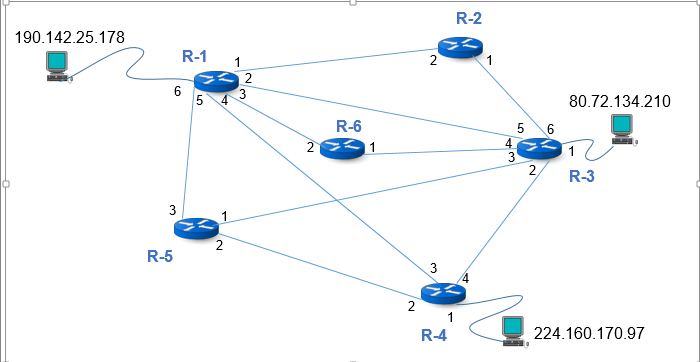Question
334) Could you please solve this problem? I have already got the answers of the first 6 questions from chegg, they are given below. Could
334) Could you please solve this problem? I have already got the answers of the first 6 questions from chegg, they are given below. Could you please solve the rest of them to the end (the questions from 7th to the last question). (COMPUTER NETWORKS)
PROBLEM:
"
Consider the IP network below;
 |
Assume following tables show the forwarding tables on the routers;
| R-1 | R-2 | R-3 | |||||
| Address | Port # | Address | Port # | Address | Port # | ||
| 224.100.200.70/6 | 1 | 227.15.278.40/4 | 1 | 183.25.247.14/5 | 6 | ||
| 224.174.142.98/11 | 5 | Default | 2 | 232.74.194.12/6 | 6 | ||
| 80.72.141.135/20 | 4 | 225.95.20.137/5 | 3 | ||||
| 80.72.160.65/20 | 2 | 95.42.245.23/27 | 4 | ||||
| 188.10.20.30/4 | 6 | 211.100.14.29/13 | 2 | ||||
| Default | 3 | 125.40.80.69/22 | 5 | ||||
| Default | 1 | ||||||
| R-4 | R-5 | R-6 | |||||
| Address | Port # | Address | Port # | Address | Port # | ||
| 224.172.253.95/8 | 1 | 226.235.187.43/6 | 3 | 179.34.226.65/4 | 2 | ||
| 80.72.175.242/19 | 4 | 224.183.75.122/11 | 2 | Default | 1 | ||
| 195.29.110.77/25 | 2 | 90.200.41.13/23 | 2 | ||||
| Default | 2 | 128.12.56.174/12 | 3 | ||||
| Default | 1 | ||||||
Given that the following data is an IPv4 datagram;
0100011010001011000000000011100000010110100011101000000001001110000011000001000100101100011110011011111010001110000110011011001011100010110000110010111101101110001111000101100100111110010101110000101100111100000001011000100100000000001000000011011010001101010100110110010101100011011100100110010101110100001000000110001101101111011001000110010100100000011010010111001100100000001100010011100100110000001101110010110000100000010001100100001000101110
Answer the following questions;
What is the datagram ID in the given datagram?
What is the length of the given datagram and what is indicated in the datagram-length field? Is the length correct?
Is the given datagram an original one or a fragment? If it is a fragment then how many bytes are there in front of this fragment?
How many bytes of a network header are there in the datagram?
What type of an upper-layer-protocol is indicated in the datagram header?
Is the header checksum correct?
What are the source and destination IP addresses? Write the IP addresses on the table below and in the indicated notations.
| Dotted-Decimal Notation | Hexadecimal Notation | |
| Source IP | ||
| Destination IP |
How many bytes are there in the datagram payload?
What are the source and destination port numbers indicated in the transport layer header?
Source port number :..(in decimal)
Destination port number :..(in decimal)
Write the message in the following notations;
Hexadecimal notation:
ASCII notation:
Write the visited router names in visiting order for the datagram which is transmitted from the host with IP 190.142.25.178 to the host with IP 80.72.134.210
The order of the routers visited:
Assume the above given datagram is at the router R-2. Write the visited router names in visiting order for this datagram until it reaches to the destination.
The order of the routers visited:
"
----------------------------------------------------------------------------------------------------------------------------------------------------------------------------------
THE ANSWERS I GOT FROM CHEGG :
1. If you mean IPv4 header for a datagram message by Datagram ID, then it is 20 bytes in case of IPv4. Hence for this message, the first 20 bytes (8x20 Bits) are the header.
Hence : 01000110100010110000000000111000000101101000111010000000010011100000110000010001001011000111100110111110100011100001100110110010111000101100001100101111011011100 is your answer.
2. The length of the given datagram is 447 Bits approximately. The length of the datagram is defined the bytes from 16th to 32rd bit. In other words for this particular case it is : 000000000011100. Converting it into bytes would give us 0001 1100 = 30, which is incorrect in this case as the total length is 447 bits.
3. I am guessing by the term fragment you mean that if the data has been trimmed to fit into the packet size as per the protocol. Then in that case this is not a fragment. I can be considered as a complete datagram packet.
4. In an Ipv4 datagram, the header is of 20 bytes size by default.
5. The upper layer protocol defined by the datagram unit is mentioned from the 72nd bit to 79th bit. In this case it is : 0000 1000 which signifies ICMP protocol.
6. The checksum is calculated as 1s complement of the 16 bit chunks in iPv4 header followed by 1s complement of the final answer. In this case, the 16 bit words in IPv4 header in Binary and Hexadecimal format are :
0100 0110 1000 1011 468B 0000 0000 0011 1000 0038 0001 0110 1000 1110 168E 1000 0000 0100 1110 804E 0000 1100 0001 0001 0C11 0010 1100 0111 1001 2C79 1011 1110 1000 1110 BE8E 0001 1001 1011 0010 19B2 1110 0010 1100 0011 E2C3 0010 1111 0110 1110 2F6E
and the sum for all the numbers in hexadecimal format equals to : 9D
1s complement of 9D is 1111 1111 0110 0010. The checksum for the IPv4 datagram packet is equal to the data in 80th to 95th bit i.e. 1001 0110 0011 1100. Since these two are not equal, hence the checksum is incorrect.
190.142.25.178 R-1 R-5 R-6 R-2 R-4 80.72.134.210 5 6 R-3 224.160.170.97 190.142.25.178 R-1 R-5 R-6 R-2 R-4 80.72.134.210 5 6 R-3 224.160.170.97Step by Step Solution
There are 3 Steps involved in it
Step: 1

Get Instant Access to Expert-Tailored Solutions
See step-by-step solutions with expert insights and AI powered tools for academic success
Step: 2

Step: 3

Ace Your Homework with AI
Get the answers you need in no time with our AI-driven, step-by-step assistance
Get Started


